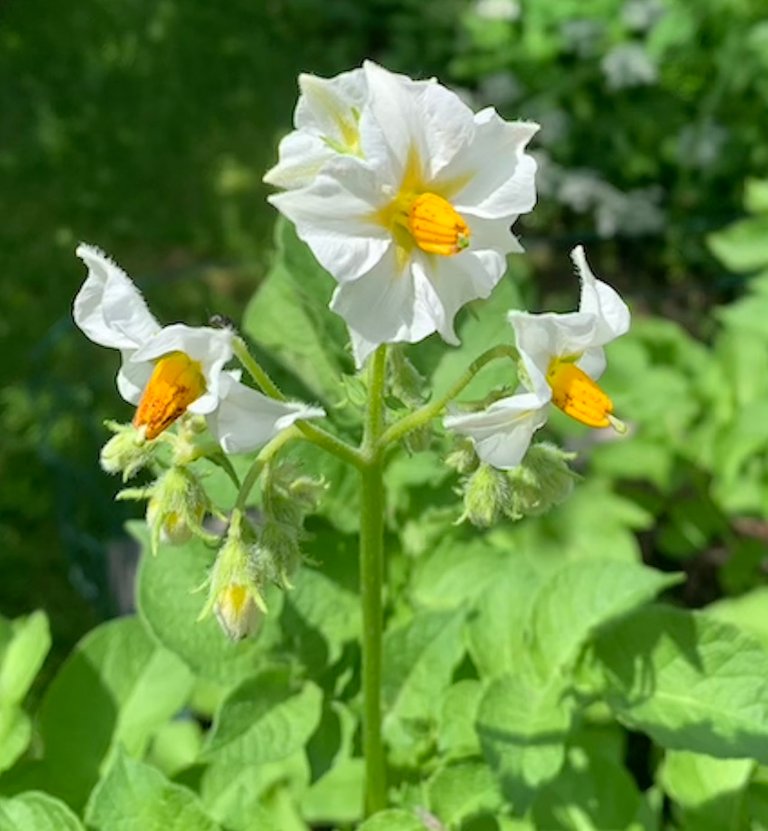
As the season progresses, everything is green, healthy and the weather has more-or-less been cooperating. The garden is essentially free of major problems.
It’s safe to assume that the majority of the success is courtesy of good luck.
Yet, failure is on the horizon.
Not with everything though. However, as I wrote in my previous State of the garden post, this year’s garden is meant to be a learning opportunity. Failure is part of learning. And yes, so far the lessons learned are adding up.
In fact, I’ve already started planning next year’s garden layout based on what I’m learning so far. Mind you, I expect more changes by the time this season ends.
More on my gardening education below.
Planning next year’s garden
When I finalize next year’s rough plan for the 2023 season, I will share it with you all.
In the meantime, it’s fair to say that – along with keeping companion planting in mind – I will also need to consider placement of shade producing plants vs the sun-loving plants.
Second round of radishes
The first batch of radishes was a mix of win and lose. I harvested a few good ones but much of the crop didn’t develop properly. They didn’t take on that plump, round shape.
I thought that either I did not thin them enough as they were coming up – and they became to crowded – or maybe I didn’t plant the seeds deep enough.
I decided to give these radishes another shot. I planted them deeper that is suggested on the seed package and – this time – I made sure to thin them out when they started popping up.
So far so good, but I still don’t know for sure. Hopefully this second crop will be better.
Fingers crossed!
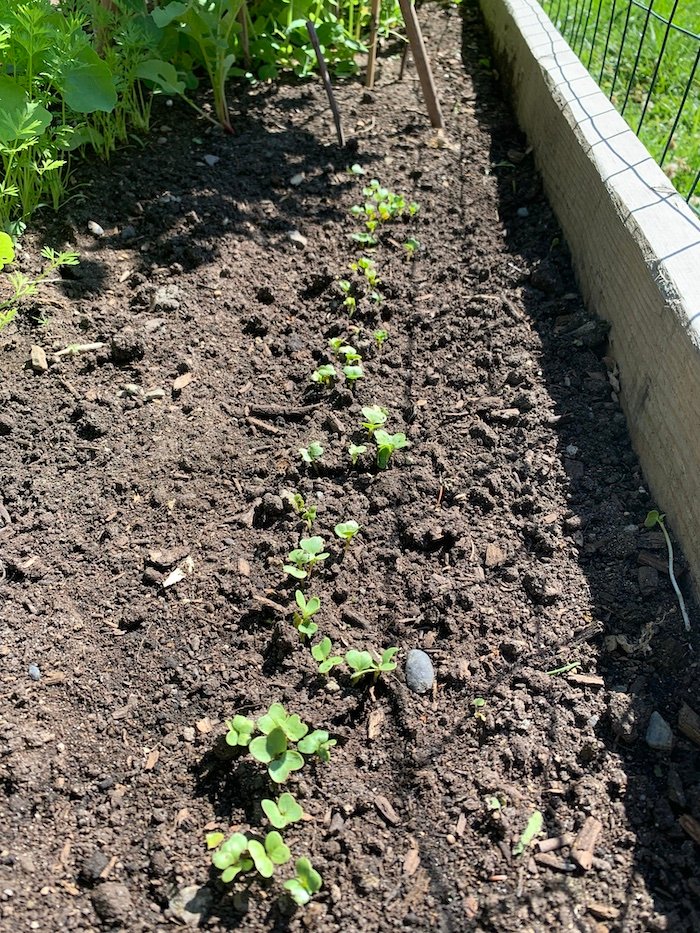 Another shot at the radishes
Another shot at the radishes
Sun, shade, too late, a lot of foliage
Perhaps the most important lesson I learned (so far) this year involves another type of radish; the Daikon. Like everything else, it was the first time trying and to be honest, I didn’t even know if they could grow in my area.
I’m happy to report that they sure can grow here. And super easy too!
But but but… Where do I start?
Timing
In Japan, daikon are known as winter vegetables. They prefer cooler weather and will “bolt” as soon as it gets too hot. Even the seed package says so. In fact, the instructions say that they should be planted in August and harvested later in the Fall.
It makes sense! From late summer and into Autumn, the temperature gets progressively colder and the daikon should be able to thrive and grow big – like they’re supposed to – (because they’re staying in the ground longer) without bolting.
But I didn’t follow the instructions.
I figured, even though we were heading into summer, I’d have enough time to grow a few big daikon before it got too hot. It did not work out that way. I figured wrong.
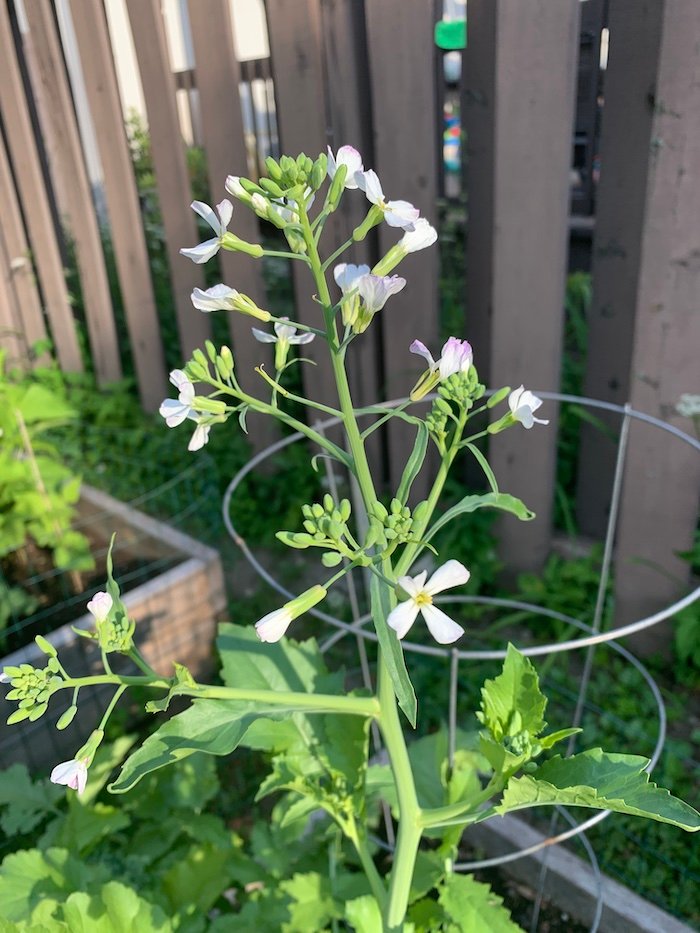 Bolting daikon plant
Bolting daikon plant
As you can see from the picture above, it got hotter too quick and the daikon have started to bolt. The ones in the ground now will not turn into the big, huge crop I was hoping to harvest.
Lesson learned! I will try again closer to the end of summer.
And if next year I want to try again in the Spring, I’ll plant them much earlier in the season.
Foliage
Another lesson learned – involving the daikon – has to do with its foliage. There’s a lot of it and the leaves are big. This means that it can be problematic if you plant them too close to sun-loving plants like tomatoes, bell peppers and jalapeno peppers.
I find the daikon foliage is interfering with my pepper and tomato plants. Those closest to the daikons aren’t growing very fast at all. At least not when compared to those not too close to the daikons.
And so, this is where I see a lot of failure. It’s starting to look like a lot of my tomato and pepper plant simply won’t produce anything edible this year.
They’re simply being shaded too much by the daikon foliage.
Lesson learned! Next time I’ll keep them away from the plants that want as much sun as possible.
Shade
Since I’m on the topic, another lesson I’m learning is that I have to better plan where I put the taller and more foliage producing plants. Most likely that’s what my rough plan for next year’s garden will reflect.
The location I picked out for this year is basically backwards to what it should be. Many of the plants that love and need lots of sun are placed behind tall or leafy plants (green peas and daikon’s foliage) and are deprived of the sunlight.
They are spending too much of their days in the shade.
Lesson learned! Next year taller plants, and those that produce a lot of shading foliage will be planted “behind” plants like bell peppers, zucchinis and tomatoes.
The flowers are kind of nice
Surprisingly, even though I’m growing these plants to eat, many of them produce flowers and I find that – in their own way – they’re not completely devoid of beauty.
Not only does the bolting daikon produce a nice little white flower (see above) but so do potato plants, green peas, zucchinis and cucumbers.
I snapped a few pictures and wanted to share them here:
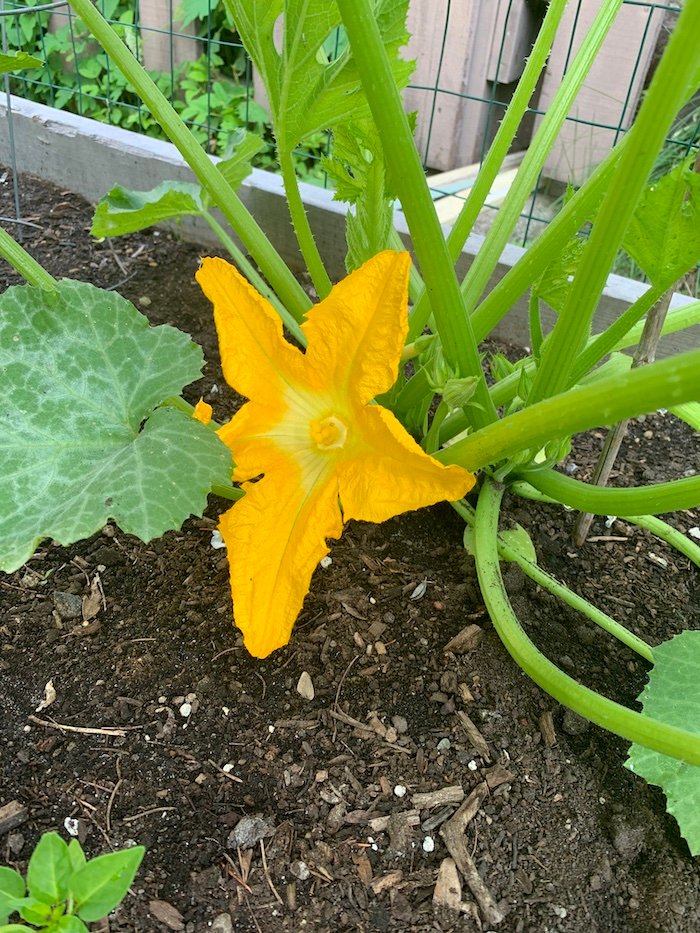 Flowering yellow zucchini
Flowering yellow zucchini
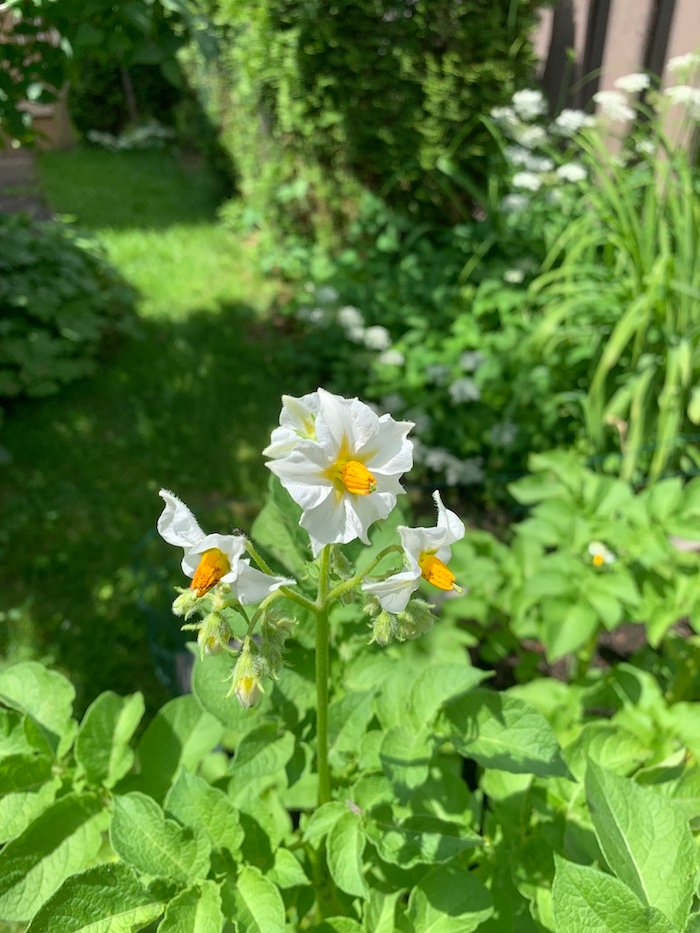 Flowering potato plant
Flowering potato plant
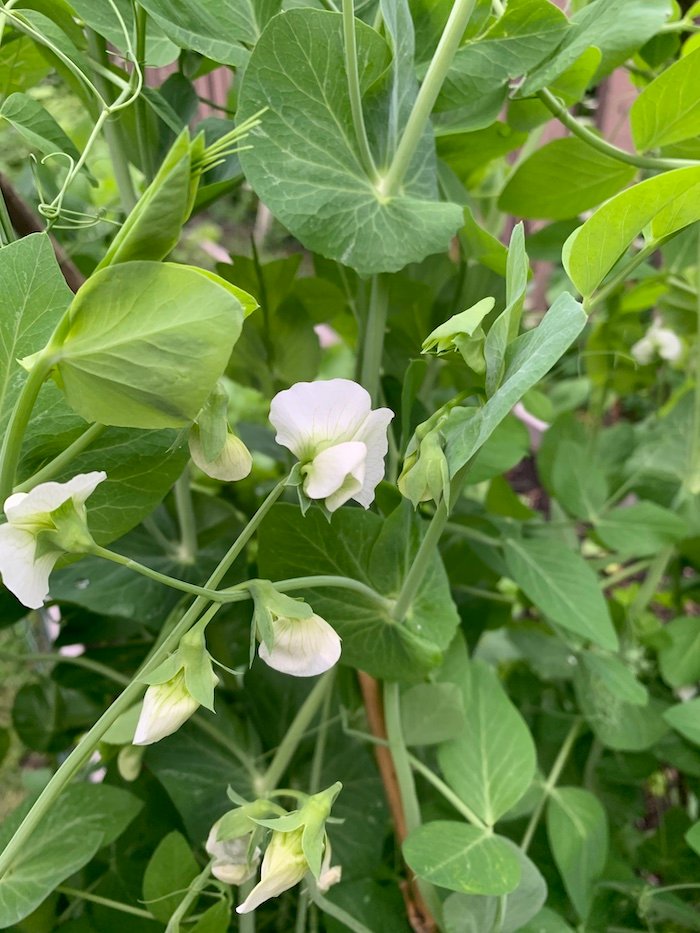 Green peas flowering
Green peas flowering
 Small cucumber already has a flower
Small cucumber already has a flower
Something to eat
One more thing about the daikon… Not having those big huge daikon radishes isn’t all bad. It turns out that – when smaller – they taste nearly identical to their smaller, red, bulbous cousins.
So we’ve been eating them. We’re putting them in salads, stir fries and even miso soup.
Delicious!
If it turns out that the small, red radishes give me too much trouble I’ll simply grow daikon and harvest them earlier than normal instead.
In any case, we’re eating them. And, in my opinion, they are great!
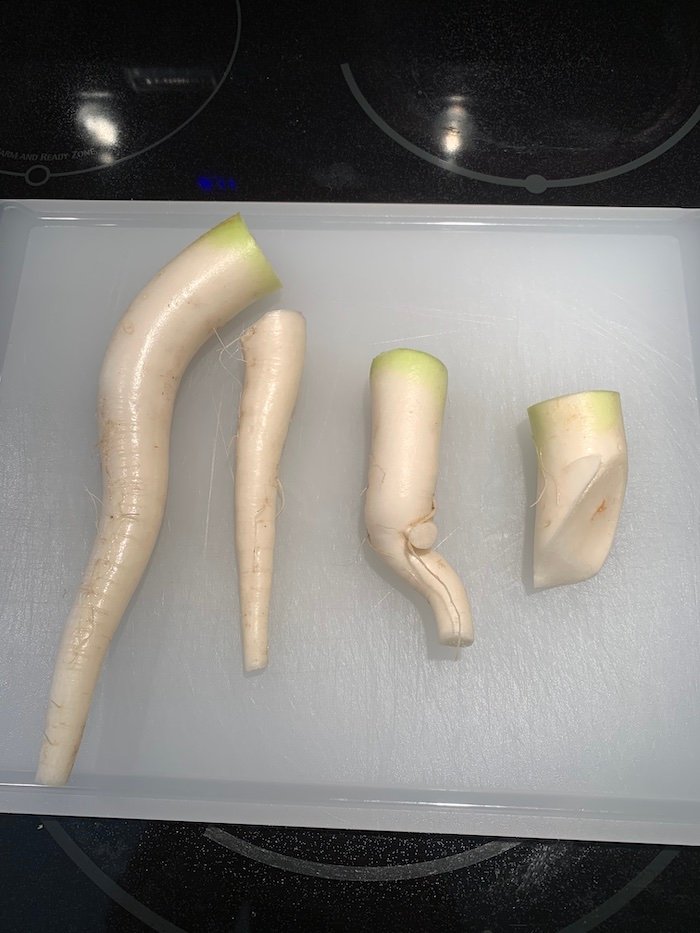 Not fully grown daikon
Not fully grown daikon
We’ve started eating something else too; green peas. And they sure are a hit with the family! When I manage to get my hands on them ( I explain below) we use them in soups and add them to some recipes that involve rice.
On their own they also make a healthy little snack.
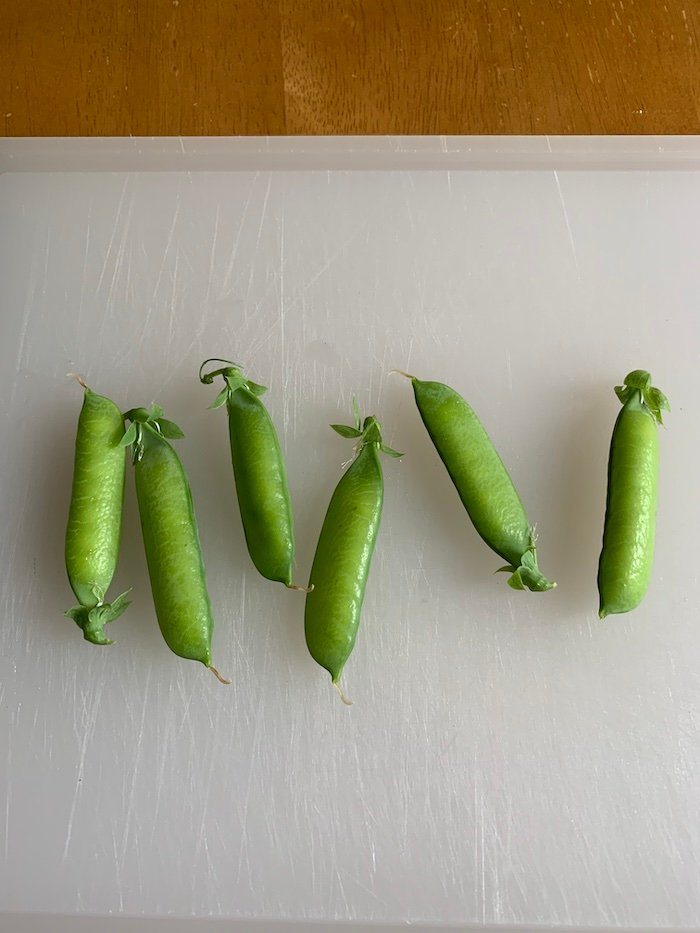 Delicious green peas
Delicious green peas
According to WebMD, green peas carry quite a punch when it comes to nutrients and health benefits.
The high concentration of vitamins, minerals, antioxidants, and phytonutrients in peas provides important health benefits that range from keeping your eyes healthy to protecting you against certain cancers.
Eye Health
Peas contain the carotenoids lutein and zeaxanthin. These nutrients help protect your eyes from chronic diseases, such as cataracts and age-related macular degeneration. Lutein and zeaxanthin act as filters from harmful blue light, which contributes to cataracts and macular degeneration.
Digestive Health
Peas are rich in coumestrol, a nutrient that plays a role in protecting against stomach cancer. A 2009 study done in Mexico City showed that daily intake of peas and other legumes lowered the risk of stomach cancer by 50%.
Peas are also high in fiber, which helps move food through your gut for easier digestion.
Immune Health and Anti-Inflammatory Properties
Peas are packed with antioxidants, which help build your immune system. The following are nutrients in peas that act as antioxidants:
Vitamin C
Vtamin E
Zinc
Catechin
Epicatechin
Anti-inflammatory nutrients in peas have been associated with lowering the risk of inflammatory conditions like diabetes, heart disease, and arthritis.
The following vitamins and nutrients found in peas help reduce inflammation:
Vitamin A
Vitamin B
Coumestrol
Ferulic
Caffeic acid
Catechin
Epicatechin
Pisumsaponins I and II
Pisomosides A and B
Blood Sugar Control
Peas are loaded with fiber and protein, which help to regulate the way you digest starches. The protein and fiber in peas slow the breakdown of carbohydrates and helps to control your blood sugar. Studies show that eating a high-protein diet decreases postprandial (after meals) blood sugar in people with type 2 diabetes.
Peas also have a low glycemic index. This means that you are less likely to have sudden spikes in blood sugar after eating them.
Heart Health
Inflammation and stress caused by free radicals (oxidation) can contribute to plaque formation along blood vessel walls. Omega-3 and omega-6 fatty acids found in peas help to reduce oxidation and inflammation and prevent plaques from forming.
In addition, magnesium, potassium, and other minerals found in peas can lower your risk of high blood pressure.
Nutrition
Personally, I love green peas and so do the kids.
In fact, so far they’re often out in the garden grabbing as many as they can before I can even harvest them.
Even the dog likes them! Well, he likes the pods more than anything.
Nutrition-wise, peas are a good source of vitamins C and E, zinc, and other antioxidants that strengthen your immune system. Other nutrients, such as vitamins A and B and coumestrol, help reduce inflammation and lower your risk of chronic conditions, including diabetes, heart disease, and arthritis.
Conclusion
We’ve continued to have a lot of rain this year. We’ve also had a lot of cloudy days where the sun is blocked. It might be having an additional negative impact on the peppers and tomatoes.
Still, considering my newbie status, I guess everything is going well so far. I’m learning a lot and we’re eating green peas and daikon. And by the looks of it, we may soon be adding green beans to the menu.
The next report on the state of the garden will likely be in early or mid August.
Stay tuned for that!
In the meantime, feel free to leave a comment and let me know how your own garden is doing so far.
This is probably the most in-depth informational post I've ever seen! I love reading about your learning experience. I have been gardening on this land for 10 years, and I still consider my gardens to be 'experimental'!
Thanks! I appreciate it.
I'm no farmer and this is all new to me so I fully expect to be learning for years to come. Like you, in ten years, I'll probably still consider my gardens experimental. :)
I can't argue with your trial and error approach to gardening, it's the best way to learn in my opinion. 😉 I also think that while advice is usual as a guide, all climates are different and even all gardens, so you still need to figure out your own way to garden and what will work best for you and where you are.
Loved reading about some of your journey so far.
Thanks for the comment!
Personally, I learn best by doing it. I can spend days and days reading and watching videos about gardening but until I actually start, I know I won't learn much. That's just the way I learn.
I share these posts in case it is interesting to others and maybe even helpful to someone out there.
I am having fun learning though!
Congratulations @flaglesscanuck! You have completed the following achievement on the Hive blockchain and have been rewarded with new badge(s):
Your next target is to reach 40 posts.
You can view your badges on your board and compare yourself to others in the Ranking
If you no longer want to receive notifications, reply to this comment with the word
STOPTo support your work, I also upvoted your post!
Check out the last post from @hivebuzz:
Support the HiveBuzz project. Vote for our proposal!